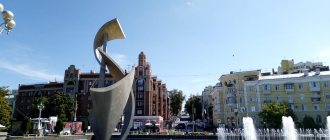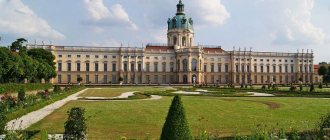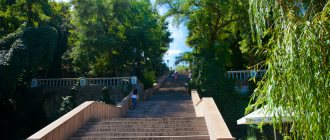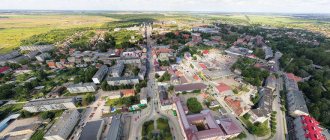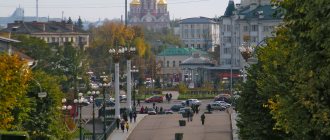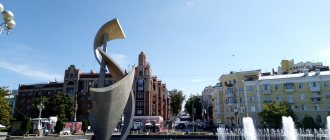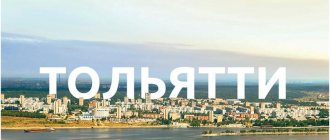Samara is a beautiful, modern city located on the Volga River. At all times of the year it attracts tourists from all over the world. Perhaps there are not many historical attractions, religious and natural monuments, but the city has enough objects that will tell the history of Russia in the 19th-20th centuries.
The longest embankment, green parks, alleys, dozens of museums with unique, rich exhibitions - these are not all the features of Samara. The diverse architectural appearance of the city, which harmoniously combines traditional classics, socialist constructivism, and modern modernism, is attractive.
History of Samara
“Samara Town” - a settlement with this name was founded on the banks of the Volga in 1586. The order to build the city was issued by Fyodor I the Blessed, who wanted to control the territories through which major trade routes passed. The first memories of the town date back to the 14th century. It is named Samar on the map of merchants from Venice.
Fortress "Samara City"
At first, mostly soldiers lived here. Trade is developing in the city, buildings with defensive walls are being built. In 1688, the city received the status of a district and at the same time the name Samara, which has survived to this day. The number of residents reached several thousand. In 1780, government institutions began to be founded here: courts, treasuries, councils. The development plan for the city territory was approved only in 1782.
Samara in the 19th century
In 1850 Samara became the center of the province. Population: 15,000. This figure increases to 90,000 in just 50 years. Bazaars and large fairs are held here, where residents of neighboring settlements come to sell agricultural products, household items, gold and silver items, and textiles. In 1877, a railway was built through Samara, and the local marina received up to 1000 ships a year. Trade is developing rapidly, the city is being actively built up with merchant palaces and estates, some of which have been preserved in good condition.
Samara in the twentieth century and today
The years 1917-1918 were marked by the establishment of Soviet power here. Since 1935, Samara has been called Kuibyshev. After the collapse of the USSR, the historical name returned. During the Second World War, aircraft manufacturing was actively developing in the city, famous military aircraft and attack aircraft were being assembled. Soon enterprises specializing in the development and creation of rockets appeared. The aerospace industry made a major contribution to the formation of the city's economy.
Today Samara is an important economic, cultural, scientific center in which industry is actively developing. In addition, it is an interesting tourist city with an abundance of modern and historical sites.
Sights of Samara
There are few historical monuments, but this will not prevent you from having an interesting and exciting time. Visit the gallery, which displays paintings by famous artists. You can walk through museums with unique exhibitions and ancient collections, or stroll along Leningradskaya Street, along the city embankment.
Samara embankment and beach
This is the most popular place among city residents and a must-see for tourists. The length of the equipped embankment is 5 km. It was reconstructed just a few years ago: fountains were installed, new benches for relaxation, a path for cyclists was laid out, and interesting sculptures were installed. You can walk along the embankment endlessly; it is beautiful here, especially on a spring or summer evening.
Zhigulevsky plant
The Zhigulevsky plant is a real pearl for lovers of intoxicating drinks. This is where the famous Zhigulevskoye beer is made. The plant itself is located in a house that is an important architectural monument. Tourists are given a fascinating excursion and are also offered to try a foamy drink. In the store at the factory you can buy several bottles of beer for yourself or as a gift.
Stalin's bunker
Joseph Stalin was very prudent, so he carefully prepared in case of nuclear war. Shelters were established in different cities of the USSR. They were built in dugouts at a depth of several meters. The Samara bunker was declassified only in 1990. The object lies under the building of the Academy of Culture and Arts. The building is not afraid of any external influences and provides the highest degree of protection against bombing. Today excursions are organized here.
"Russia is my history"
An interesting modern facility will open in 2022. The construction of this park was timed to coincide with the World Cup. Of course, you won’t be surprised by archaeological finds and historical exhibits here, but a pleasant experience from visiting the park is guaranteed. Using multimedia technologies, the history of Russia is demonstrated on large interactive screens. Tourists are offered to listen to stories about one or another historical period, watch films and videos, and get acquainted with unique collections of valuable exhibits, although they are presented only in electronic form.
Iversky Convent in Samara
The monastery was created no more than 150 years ago. The monastery still operates today, being considered the oldest in Samara, and is a unique architectural complex that consists of religious shrines, residential buildings, and utility buildings. Pilgrims from all over the world often come here. From afar you are attracted by the sparkling gilded domes of the temples. Several years ago the buildings were restored. The monastery houses the relics of St. Alexander Chagrinsky. There are workshops and a library at the monastery. You can freely walk around the territory of the Iversky Convent, but the cells of the monks are not available for inspection.
Samara Space Museum
Since the Second World War, Samara has served as a rocket science center. Launch vehicles, components for missiles, and ballistic missiles are developed at the local factories. The Vostok model was released in Samara, on which Yuri Gagarin flew into space. The Samara Space Museum is a huge complex consisting of 3 floors. The main exhibition is located on the 1st floor, and additional collections are located on the 2nd and 3rd floors. The institution is open from Tuesday to Friday according to the schedule from 10.00 to 18.00. Saturday and Sunday are shortened working days.
Kurlina's mansion
Kurlina's mansion is a beautiful historical building with Art Nouveau features. This is an important part of the urban landscape of Samara. The estate was described by A. Tolstoy in his novel “Walking Through Torment.” The house was built by order of the wealthy Kurlins. They spared no expense and invested considerable funds in the development of the city’s culture and infrastructure. Today, in the building of the mansion there is a Museum of Art Nouveau, which presents unique exhibitions that testify to the development and formation of the Art Nouveau movement. 100-year-old interiors surprise with their originality and unusualness. They have been perfectly preserved to this day.
The mansion attracts attention at first sight. The façade of the building is lined with spectacular blue tiles, which enchant with their elegant gloss. The overall composition is complemented by a white base and green inserts. Stucco was used as decoration. The pediment is decorated with a sculpture of a woman's head, the windows are decorated with plant stems, and the cornices are decorated with forging in the form of dragonflies and butterflies. On the 1st floor, the typical interior of merchant housing of the 20th century has been preserved. The interior space is divided into a large hall, a dining room, a boudoir, and a study. A separate exhibition consists of expensive household items: elegant accessories, festive and everyday outfits, paintings, dishes and cutlery, luxurious furniture. On the stands accompanying the collection there is an informative explanation with a brief historical background.
Wonderland Park "Galileo"
Galileo is a find for visitors of all ages. Here are the most interesting physical phenomena presented in a fun, accessible way. Among the exhibits, special attention is drawn to:
- a labyrinth with mirrors;
- an upside down room;
- magic balls and other similar attributes;
- a talking head without a body;
- infinite cube, etc.
The total number of exhibits exceeds 50. A guide or consultant will help you understand them; they are in every room. The park also has its own laboratory, where visitors are invited to participate in experiments.
Roman Catholic Church of the Sacred Heart of Jesus
A luxurious, austere religious landmark with tall spiers and severe forms, built in 1906. The implementation of the Moscow architect's project took 4 years. Today this building is known as the Polish Church. The temple was not destined to exist for long. As soon as Soviet power settled on the territory of Samara, the shrine was closed. Valuable historical monuments stored here were confiscated and sold in the 30s of the twentieth century. The temple turned into a deserted place, where over time a children's theater was located, then a cinema and drama school, later a construction club, then an anti-religious museum.
Only in 1991, after the collapse of the USSR, the functionality of the shrine was resumed. And after another 5 years, a major restoration is carried out and the temple is reconstructed. Today it attracts not only believers, but also tourists, because it is an important architectural and religious landmark of the city. You can examine its unique facades from the outside, go inside and admire the original interiors. The Divine Liturgy is regularly served here and concerts of classical and sacred music are organized.
Strukovsky Garden
The oldest and most majestic park in the city of Samara. Guests and locals love to relax here. Clean air, alluring nature, well-developed infrastructure - this is what attracts Strukovsky Garden. For vacationers there are comfortable benches, for cyclists there are equipped paths, for connoisseurs of natural aesthetics there are beautiful fountains and waterfalls. In the center there is a statue of a wild goat, which is considered the symbol of this region. By the way, members of the chess club often organize competitions here. You can just come and play mind games.
House with elephants
You can't pass by the house with the elephants. He's very unusual. The modern building effectively complements the city’s landscape and gives it a special charm. The mansion was built in 1909. Well-known architects of that time worked on the development of design documentation: P. Golovkin, V. Tepfer. Golovkin was also the customer; he was a merchant, was a patron of many cultural objects, and painted pictures. The architecture of the building combines features of Art Nouveau and the Viennese Secession, which is quite unusual for a provincial Russian town of the early twentieth century.
Singing fountains of Samara
Spring and summer evenings in Samara are something exciting and memorable. Take a stroll by the CSKA VVS pool. Amazing singing fountains attract attention here. With their help, light and sound shows are organized. Water jets form atypical shapes that swirl, shimmer, play in different colors, and all this is accompanied by pleasant music. The musical compositions are chosen very well, they play modern compositions and classics (Mozart, Vivaldi, etc.). If you get closer to the fountain, you can get under the refreshing stream. This place is considered one of the most romantic in Samara; couples in love love to stroll here. The embankment near the singing fountains is always fun and crowded, there are performances and street musicians playing.
Samara has something to surprise you with. The city is developing rapidly, characterized by a well-developed tourist infrastructure and an abundance of modern attractions. In Samara you can have a pleasant time at the zoo, indoor water park, cat cafe, and entertainment centers. There are also many restaurants, hotels, and cafes that happily welcome tourists from different regions of the country.
DEMOLISH CANNOT BE LEAVED
More recently, the landscape of the main street of old Samara has been enriched with a new monument. But today we will not talk about him, but about the well-forgotten old one. About those monuments that have been erased from the face of Samara by the inexorable pace of history.
MONUMENT TO ALEXANDER II
Sculptor - Vladimir Sherwood, opening date - 1889. Before the revolution it was the only monument in Samara. In addition to the emperor himself, 4 symbolic figures were added to the composition of the monument: a Russian peasant making the sign of the cross; Circassian breaking a saber; a Bulgarian woman thanking Alexander II for the liberation of her homeland, and a Central Asian woman throwing off her veil.
During the Civil War, the monument disappeared without a trace. In 1927, the leader of the world proletariat took the place of the emperor. Unlike Alexander II, who admired the Volga, Vladimir Ilyich looks towards Leningradskaya.
SCULPTURES OF LENIN AND STALIN NEAR THE OLD RIVER STATION
In 1936, a new comfortable river station was built in Samara, then Kuibyshev. It was located between the Leningradsky and Nekrasovsky descents, closer to the second. The departing citizens were seen off on their good journey not by anyone, but by the leaders themselves - Vladimir Ilyich and Joseph Vissarionovich.
During the fight against the latter’s personality cult, both sculptures were removed out of harm’s way, and in 1969, construction began on a new river station.
MONUMENT “STALIN AND LENIN IN GORKHI”
Let's not go far from the Volga. This is a typical monument that was installed at the Administration of the Volgotanker River Shipping Company on Maxim Gorky Street.
After the debunking of Stalin’s personality cult, he was kicked out of the shop. Vladimir Ilyich remained sitting on it alone, sadly peering into the distance. Rumor has it that some lonely people, exhausted by Narzan, sat down in the vacant seat in order to improve their health in the company of a cultured person. As a result, the monument was completely dismantled.
SCULPTURES OF WARRIORS NEAR THE OFFICERS' HOUSE
The pilot peers into the cloudless Samara sky. Maybe this is Valery Chkalov, after whom the descent to the Volga, a street, an alley and a village in the Kirovsky district are named in Samara. But this is unknown for certain, as is the year of dismantling of these sculptures.
Photo taken from Vladimir Samartsev’s book “Unprecedented Samara”
MONUMENT TO THE THIRD INTERNATIONAL
In a nutshell, the 3rd International is an international organization that united the world's communist parties and existed from 1919 to 1943. In Samara they decided to dedicate a monument to him. But the time was hungry and restless, and therefore the monument was not very large. He represented bent workers holding our blue ball on their muscular shoulders, like Atlases.
By 1932, the monument was almost completely destroyed and was dismantled without pity, and its place was taken by Vasily Chapaev and Co.
FIRST AND SECOND MONUMENTS TO PUSHKIN
We are talking, as you understand, about Pushkin Square. The Alexander Sergeevich who is standing there now is already the third in a row. The first one (pictured left) was installed in 1905, was made of plaster and stood until the mid-1930s. The second, already concrete, appeared here in 1949, and was dismantled for unknown reasons in 1962.
The third coming of Alexander Sergeevich to Pushkin Square occurred in 1985.
A MAN WITH A CHILD IN HIS HANDS
There were at least two copies of the typical Soviet sculpture in Kuibyshev. On the Agriculture Square (on the left) and near the old railway station building.
SCULPTURES OF WORKER AND RED ARMY MEMBER
Photo courtesy of Armen Arutyunov
They were guarding the entrance to the building of the Samara-Zlatoust Railway Administration. They were apparently dismantled during the “thaw” and replaced with flowerpots.
Unfortunately, it was not possible to find close-up photographs of these revolutionary guards, but from what is available, their silhouettes can be seen.
BUSTS OF SAMARA MERCHANTS
On the left is the unveiling of a bust of Anton Shikhobalov near the hospital he built on Sokolnichya Street. It took place in 1909. The construction of the hospital cost A. Shikhobalov 190 thousand rubles. Sokolnichya Street, on which it was located, was renamed Shikhobalovskaya and bore this name before the revolution. The current address of the hospital is st. Leninskaya, 75. It has been under reconstruction for many years, and it is unknown when it will be completed.
On the right is a bust of the merchant Yakov Sokolov next to the almshouse he built. By the way, bronze. Opened on August 21, 1911. The construction of the almshouse cost 200 thousand rubles. For comparison: the famous Kurlina mansion cost ten times less. The current address of the Sokolovskaya almshouse is st. Chkalova, 98. However, now it is not lonely elderly people who spend time there, but the escort department of the GUFSIN.
DOBRYNA AND THE SNAKE
An epic sculptural composition that previously adorned the fountain near the Skazka cafe in the village of Upravlencheskiy. Depicts the epic duel between the hero Dobrynya Nikitich and the filthy Serpent.
